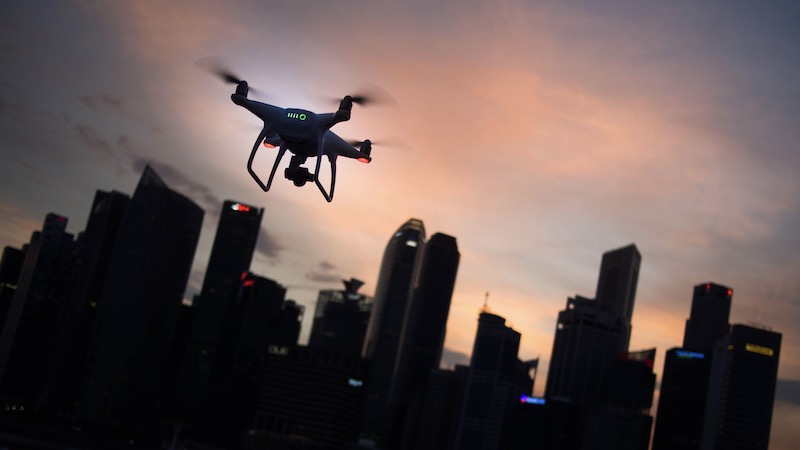In recent months, the Amazon subsidiary Prime Air has been working on an Amazon drone delivery – and has now laid off employees because the e-commerce giant wants to work with external specialists. The first steps towards the parcel delivery of the future?
It is the year 2020 – and Amazon actually wanted to have already started with the parcel delivery of the future: an Amazon drones delivery. The e-commerce giant has been planning for some time now to take advantage of the technology and replace parcel deliverers with drones.
To this end, the Amazon subsidiary Prime Air is working with its own employees on the development and production of special logistics drones. But Amazon does not seem to be satisfied with the results so far.
Amazon drone delivery: Prime Air fires its employees and hires drone specialists
According to a report in the Financial Times, Amazon has in fact laid off dozens of employees in order to merge with external drone specialists.
According to the report, Amazon has already conducted negotiations and is close to completion. In addition to some US-American partners, European specialists are also to belong to the chosen circle.
According to the Financial Times, one of them will be FACC Aerospace, a leading Austrian company in the design, development and production of systems for the aviation industry. The Spanish aerospace company Aernnova, based in Vitoria, will also be among them.
Apparently Amazon is also planning further partnerships in order to position itself as broadly as possible and to realize the Amazon drone delivery. Due to the Corona crisis, however, it is difficult to estimate when the e-commerce company will start its new parcel delivery service.
Amazon drone delivery: What will the parcel delivery of the future look like?
All too soon, drones will not be able to replace human parcel carriers. Unmanned aircraft can deliver parcels up to a certain weight. But when it comes to large and heavy deliveries, we depend on our human capabilities.
In June 2020, Amazon unveiled a delivery drone that can fly 24 kilometers and deliver packages weighing up to 2.3 kilograms within 30 minutes. The devices could therefore provide regional support for letter carriers and relieve them of work.
In September 2020, the U.S. Federal Aviation Administration (FAA) also approved the drone delivery to Amazon. And the e-commerce giant is not the only company.
In April 2019, the Alphabet subsidiary Wings was also authorized to carry out deliveries with drones. This was followed in October 2019 by a confirmation for the parcel delivery company UPS.
What does a drone delivery look like?
Wing sent its first drones into the air last year in Christiansburg to ship small packages, over-the-counter medicines and sweets from retail partners.
Package recipients must agree to the drone transport and specify a delivery location on the property. The delivery can be tracked in real time via app.
Upon arrival, the drone slowly lowers the delivery by rope to the specified delivery location and, if desired, informs the customer with a push notification on the smartphone.
What problems are there with parcel delivery by drone?
The specified delivery location is one of two major problems with parcel delivery by drone.
Ideally, airplanes help to relieve human mail carriers. Especially in large cities, the parcel flood is huge because more people live in less space and more orders come together.
In addition, logistics space in large cities is often limited. Letter carriers can hardly keep up with the pace, have to postpone deliveries until the next day or take them to the nearest post office.
But especially in large cities and inner cities, drones can fly badly. Where should the aircraft land, for example, in narrow residential areas or busy main roads? There are often no land areas where the drones can land.
And that leads us to the second problem: Up to now, the drones can only cover distances of 20 to 30 kilometers. In other words, you can’t use them across cities.
The aircraft can only ever provide regional assistance. Accordingly, a large number of drones would be needed for good coverage. And that would probably be expensive.
What solutions are available?
Theoretically, parcel delivery companies such as DHL, UPS, Amazon and Co. could open up new post offices where the drones could land even in large cities.
Landing pads for delivery drones could be compared to parcel stores where customers could pick up their deliveries if they missed the messenger at home. The landing pads should of course be widely spread, so that customers only have to cover a short distance to pick up their delivery.
Which parcel deliverers are still working on a drone delivery?
Despite everything, the strong efforts of Amazon and Co. show that delivery drones could soon become part of our everyday lives.
A survey conducted by the digital association Bitkom in 2019 also revealed that one in two consumers would like to have medicines and purchases delivered by drone.
The interest in drone deliveries does not pass the postal delivery staff by. DHL has been working for years on a parcel copter project in which a small helicopter flies to a loading and departure station and is loaded with parcels fully automatically. Entire roofs of logistics centers could be built according to this concept.
In China, DHL then launched a delivery service in 2019 using the latest Falcon drones from Ehang. And speaking of China: Ele Me is already delivering food by drone in an industrial park covering a total of 57 square kilometers.
The drone takes the goods from one drone station to the next, so that customers only have to pick up their goods there. In China, the technology is therefore already being used more often and more effectively.
For larger loads, Boeing has also built the so-called Octocopter, which can lift over 200 kilograms. However, this should not be used in normal everyday delivery operations.
Nevertheless there are already appropriate devices. What is still lacking is a suitable concept for everyday use and the corresponding logistics. But Amazon and Co. are also working hard on this.










